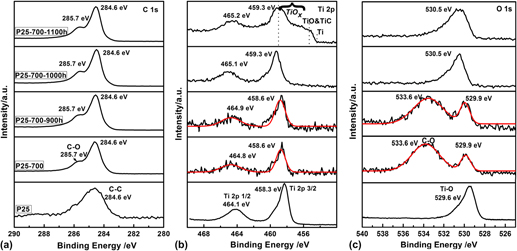Crossref Citations
This article has been cited by the following publications. This list is generated based on data provided by
Crossref.
Tang, Dingding
Xiao, Wei
Tian, Longfei
and
Wang, Dihua
2013.
Electrosynthesis of Ti2COnfrom TiO2/C Composite in Molten CaCl2: Effect of Electrolysis Voltage and Duration.
Journal of The Electrochemical Society,
Vol. 160,
Issue. 11,
p.
F1192.
Lee, Deok Yeon
Kim, Eun-Kyung
Yoon, Seog Joon
Lim, Iseul
Cho, Keumnam
Shinde, Dipak V.
Patil, Supriya A.
Lee, Wonjoo
Nah, Yoon-Chae
Shrestha, Nabeen K.
Lee, Joong Kee
and
Han, Sung-Hwan
2014.
A facile approach for carburization of anodically grown titania nanotubes: towards metallization of nanotubes.
RSC Advances,
Vol. 4,
Issue. 62,
p.
32599.
Huang, Kan
Li, Yunfeng
Yan, Litao
and
Xing, Yangchuan
2014.
Nanoscale conductive niobium oxides made through low temperature phase transformation for electrocatalyst support.
RSC Advances,
Vol. 4,
Issue. 19,
p.
9701.
Zhang, Jun
Ni, Jiangfeng
Guo, Jing
and
Cao, Bingqiang
2014.
TiO2@C composite nanospheres with an optimized homogeneous structure for lithium-ion batteries.
New J. Chem.,
Vol. 38,
Issue. 8,
p.
3722.
Calvillo, Laura
Fittipaldi, Diego
Rüdiger, Celine
Agnoli, Stefano
Favaro, Marco
Valero-Vidal, Carlos
Di Valentin, Cristiana
Vittadini, Andrea
Bozzolo, Nathalie
Jacomet, Suzane
Gregoratti, Luca
Kunze-Liebhäuser, Julia
Pacchioni, Gianfranco
and
Granozzi, Gaetano
2014.
Carbothermal Transformation of TiO2 into TiOxCy in UHV: Tracking Intrinsic Chemical Stabilities.
The Journal of Physical Chemistry C,
Vol. 118,
Issue. 39,
p.
22601.
Zhuang, Yan
Ding, Wei
Liu, Yuhai
Mou, Zhigang
Sun, Jianhua
and
Guan, Mingyun
2015.
Reduced nanostructured titanium oxide coating as an electrocatalyst support for methanol oxidation.
Journal of Materials Science,
Vol. 50,
Issue. 11,
p.
3875.
Shan, Zhichao
Archana, Panikar Sathyaseelan
Shen, Gang
Gupta, Arunava
Bakker, Martin G.
and
Pan, Shanlin
2015.
NanoCOT: Low-Cost Nanostructured Electrode Containing Carbon, Oxygen, and Titanium for Efficient Oxygen Evolution Reaction.
Journal of the American Chemical Society,
Vol. 137,
Issue. 37,
p.
11996.
Qin, Yuan-Hang
Li, Yunfeng
Lam, Thomas
and
Xing, Yangchuan
2015.
Nitrogen-doped carbon-TiO 2 composite as support of Pd electrocatalyst for formic acid oxidation.
Journal of Power Sources,
Vol. 284,
Issue. ,
p.
186.
Yang, Leerang
Kimmel, Yannick C.
Lu, Qi
and
Chen, Jingguang G.
2015.
Effect of pretreatment atmosphere on the particle size and oxygen reduction activity of low-loading platinum impregnated titanium carbide powder electrocatalysts.
Journal of Power Sources,
Vol. 287,
Issue. ,
p.
196.
Guan, Sujun
Hao, Liang
Yoshida, Hiroyuki
Itoi, Takaomi
Asanuma, Hiroshi
Pan, Fusheng
and
Lu, Yun
2016.
Fabrication and characterization of photocatalyst composite coatings of TiO2/TiC-Ti using Ti and TiC powders.
Surface and Coatings Technology,
Vol. 307,
Issue. ,
p.
627.
Calvillo, Laura
García, Gonzalo
Paduano, Andrea
Guillen-Villafuerte, Olmedo
Valero-Vidal, Carlos
Vittadini, Andrea
Bellini, Marco
Lavacchi, Alessandro
Agnoli, Stefano
Martucci, Alessandro
Kunze-Liebhäuser, Julia
Pastor, Elena
and
Granozzi, Gaetano
2016.
Electrochemical Behavior of TiOxCy as Catalyst Support for Direct Ethanol Fuel Cells at Intermediate Temperature: From Planar Systems to Powders.
ACS Applied Materials & Interfaces,
Vol. 8,
Issue. 1,
p.
716.
Guan, Sujun
Hao, Liang
Lu, Yun
Yoshida, Hiroyuki
Pan, Fusheng
and
Asanuma, Hiroshi
2016.
Fabrication of oxygen-deficient TiO 2 coatings with nano-fiber morphology for visible-light photocatalysis.
Materials Science in Semiconductor Processing,
Vol. 41,
Issue. ,
p.
358.
Guan, Sujun
Hao, Liang
Yoshida, Hiroyuki
Asanuma, Hiroshi
Pan, Fusheng
and
Lu, Yun
2016.
Influence of heat treatment process on photocatalytic activity of photocatalyst TiO2/TiCxOy coatings during heat treatment in carbon powder.
Journal of Materials Science: Materials in Electronics,
Vol. 27,
Issue. 10,
p.
10399.
Guan, Sujun
Hao, Liang
Yoshida, Hiroyuki
Pan, Fusheng
Asanuma, Hiroshi
and
Lu, Yun
2016.
Enhanced photocatalytic activity of photocatalyst coatings by heat treatment in carbon atmosphere.
Materials Letters,
Vol. 167,
Issue. ,
p.
43.
Yan, Litao
Rui, Xianhong
Chen, Gen
Xu, Weichuan
Zou, Guifu
and
Luo, Hongmei
2016.
Recent advances in nanostructured Nb-based oxides for electrochemical energy storage.
Nanoscale,
Vol. 8,
Issue. 16,
p.
8443.
Mu, Tianzhu
Zhu, Fuxing
and
Deng, Bin
2017.
Dissolution Characteristic of Titanium Oxycarbide Electrolysis.
MATERIALS TRANSACTIONS,
Vol. 58,
Issue. 4,
p.
535.
Chen, Zhijie
Zhu, Junqiu
Zhang, Shuai
Shao, Yanqun
Lin, Deyuan
Zhou, Jianfeng
Chen, Yunxiang
and
Tang, Dian
2017.
Influence of the electronic structures on the heterogeneous photoelectrocatalytic performance of Ti/RuxSn1-xO2 electrodes.
Journal of Hazardous Materials,
Vol. 333,
Issue. ,
p.
232.
Liao, Jin-Yun
Smith, Taylor W.
Pandey, Raja R.
He, Xiaoqing
Chusuei, Charles C.
and
Xing, Yangchuan
2018.
Substantially enhanced rate capability of lithium storage in Na2Ti6O13 with self-doping and carbon-coating.
RSC Advances,
Vol. 8,
Issue. 16,
p.
8929.
Helbig, Uta
Herbst, Kai
Roudenko, Jewgeni
Helbig, Jens
Barton, Bastian
and
Kolb, Ute
2018.
Carbon-doped titania as a precursor for titanate nanotubes.
Journal of Materials Research,
Vol. 33,
Issue. 9,
p.
1288.
Alonso-Vante, Nicolas
2018.
Chalcogenide Materials for Energy Conversion.
p.
61.
